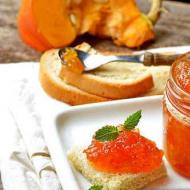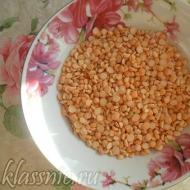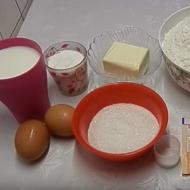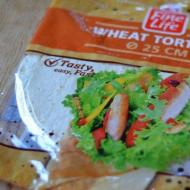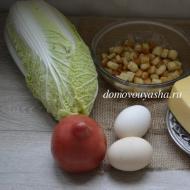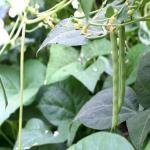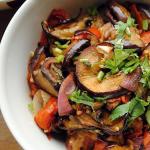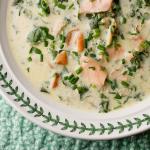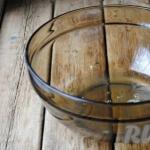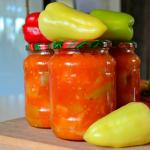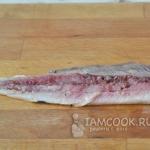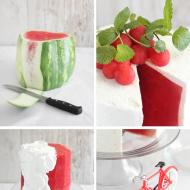
Buckwheat noodles, buckwheat groats, buckwheat flour - what are the benefits of these products? Buckwheat noodles will diversify your diet and delight the whole family Soba Japan
We all know that there are countries on our planet that are distinguished by their wise culture, longevity and unusual traditions. This includes Japan, which we can talk about for a very long time, because the country’s culture is extraordinarily beautiful, unusual, filled with special meaning, and here living to a hundred years or more is rather the norm than a surprising exception. Scientists have long proven that the secret of the longevity of the Japanese lies partly in their diet, which contains fish, rice, good teas and buckwheat noodles, which we will get acquainted with today.
Who among us doesn't love noodles? There are none, we make a side dish out of it, cook delicious soups, but for us the product is a product made from wheat flour, with the taste of traditional pasta dishes. You can buy ready-made noodles and make them yourself; the Japanese do the same thing, only the component of the product is buckwheat flour. The result is a very tasty, unusual dish, unusual for us, but no less healthy.
Buckwheat noodles among the Japanese are soba, which is included in the traditional diet of the population. What is its benefit, let's find out further.
For information! You can buy soba in our country in various stores; its color differs from our traditional products; the shade of the noodles is similar to the color of river sand. Typically, the product has a short shelf life, which can be increased by additional components in the composition.
Buckwheat noodles - let's talk about the benefits and harm
Soba and its positive effects
The Japanese are very scrupulous when choosing food, because it is clear that it affects our life, energy, and health. In their diet you can rarely find dishes that do not provide some benefit, and soba is no exception. Eating noodles in your diet can give you the following positive effects:- buckwheat noodles are made on the basis of buckwheat flour, which you can make yourself, the product ultimately contains many vitamins and minerals, which has a beneficial effect on health and immunity;
- Dogs are great for helping improve the functioning of the gastrointestinal tract;
- although the product is high in calories, you can lose weight by consuming it;
- noodles have a beneficial effect on male strength;
- helps hypertensive patients;
- the beneficial properties of buckwheat soba noodles are that it lowers blood cholesterol levels;
- By consuming the product 2-3 times a week, you can normalize your metabolism, which will have a positive effect on weight loss;
- noodles are low in fat;
- fiber in the composition improves the functioning of the digestive and excretory systems, helps to lose weight, cleanse the body of toxins and waste;
- Buckwheat noodles in your diet will have a beneficial effect on your appearance.
The soba is prepared in a special way - careful, gentle processing leaves the product with a maximum of vitamins and nutrients. There is potassium, calcium, selenium, iron, phosphorus, copper, sodium and manganese. There are B vitamins, as well as A, E, PP. The calorie content of soba is 348 kcal. As you can see, a lot, but you can still lose weight by eating the dish due to the fact that metabolism is normalized and digestion is improved.
This is interesting! Noodles made from buckwheat flour may also contain other ingredients, including green tea. This is one of the signs of a good product, so don't be surprised if you read the ingredients on the package. But if there is also wheat flour, then the dish will be higher in calories, but it will be easier to cook.
Harm from eating buckwheat noodles
As we have already said, frequent consumption of the dish can cause weight gain due to its high calorie content, so it is better to always eat soba with plenty of vegetables, no more than 4 times a week, if you want to lose weight. There are no contraindications, except for individual intolerance to the components.
If you have never purchased or eaten this product before, you may be disappointed the first time. But this is all due to ignorance, and then we advise you to read some subtleties that will tell you how to prepare buckwheat noodles, please your family and surprise your guests.
- Soba cooks very quickly and breaks easily, which is why wheat flour is sometimes added to the composition, so you can’t cook noodles as you usually do with pasta.
- You can cook soba in meat broth, which will make it even more tasty and aromatic.
- Buckwheat noodles can be eaten cold or hot, as a side dish, and as an addition to various dishes.
- The noodles are cooked very quickly; if they are then used to prepare various dishes, it only takes half a minute.
- The most delicious buckwheat noodle recipes are those with vegetables. The dish is prepared with onions, carrots, spices, herbs, tomatoes, eggplants and cucumbers.
- Soba is stored for very little time - a maximum of a week, for which it is sprinkled with flour. If the composition contains additives, the timing may increase, so always look at what the manufacturer writes.
- The cooking time may also change if the composition contains starch or algae, so again, always read what exactly this soba production company advises.
- Buckwheat noodles can be served as an appetizer with a foamy drink if you simply fry them in oil.
So, it's time to prepare delicious dishes.
Buckwheat noodles - the best recipes for the whole family
Soba with chicken
We will need:
- noodles – 200 grams;
- tomatoes - two medium ones;
- garlic cloves – 3 pieces;
- chicken meat - fillet is best - 350 grams;
- mushrooms - to your taste, you can take champignons - 200 grams;
- celery - two plant stems;
- sauce - traditionally added to Teriyaki buckwheat noodles, but you can replace it with your favorite one or the one you have on sale. You will need 2-3 tablespoons;
- oil for frying.
Let’s immediately answer the question of how long to cook buckwheat noodles. We have already said that it all depends on the manufacturer who uses certain components, so read the instructions before cooking. It's all said there. So, cook the noodles and dry them.
In a frying pan, slightly simmer the chopped garlic cloves, then add the salted fillet, fry it for no more than 10 minutes, then add finely chopped celery, peeled tomatoes, and mushrooms. All components are stewed, at the end add sauce, salt and spices to taste, simmer for 2 minutes and mix with noodles.
Buckwheat noodles with vegetables
Vegetables are traditional products for buckwheat noodles.
We will need:
- noodles – 250 grams;
- vegetables - onions, carrots, peppers, celery - just one each;
- salt and spices - to taste and preference;
- soy sauce – 3-4 tablespoons;
- vegetable oil for frying;
- ground chili pepper - on the tip of a knife;
- ground paprika – 10 grams;
- lemon juice – 20 grams or a tablespoon;
- green beans - a glass. You can buy frozen food in the frozen section of supermarkets.
Wash, peel and cut the vegetables as you prefer. Fry onions, carrots, celery and peppers in the traditional way, then add green beans. Pepper and salt everything, seasoning with slightly hot pepper. Cook the soba according to the instructions, but salt it lightly so as not to over-salt the dish when you pour the sauce over it. Which is prepared from lemon, soy sauce, you can also add a little olive oil, after which we mix everything with a whisk. We combine the noodles and vegetables together and pour our dressing on top of the dish.
Buckwheat noodles with seafood
We will need:
- noodles – 250 grams;
- champignons – 200 grams;
- green beans – 200 grams;
- broccoli – 100 grams;
- carrots - one small;
- garlic cloves – 3-4 pieces;
- frying oil;
- seafood - you can make buckwheat noodles with shrimp, squid, crab meat, buy ready-made frozen platters;
- for the sauce - 3 tablespoons of soy sauce and the same amount of rice vinegar. Two tablespoons of sesame oil.
Cook the noodles according to the instructions. Fry finely chopped garlic in a frying pan, then add chopped mushrooms, broccoli and beans. We add each ingredient one minute apart. Then pour in our three-component sauce and simmer, stirring everything together. The dish will begin to emit a wonderful aroma, also add salt and spices to taste. At the end we place frozen seafood, which is most often already sold ready-made; they just need to be heated. We add shredded carrots along with shrimp or other products; you can exclude them from the dish if you wish, or fry them together with mushrooms.
Combine everything with noodles and serve. It is very tasty, aromatic and, most importantly, healthy, because it contains seafood, vegetables and buckwheat noodles themselves. This diet will win the hearts of your loved ones and surprise all your guests. You can serve the dish with a glass of good wine.
On a note! You can make delicious and healthy soups with soba noodles. Prepare everything in the usual way - that is, broth, frying, potatoes and at the end add buckwheat noodles. It’s very simple and tasty, and, most importantly, healthy, and it’s better to take chicken or turkey meat so as not to harm your figure.
Experiment with recipes, buy beautiful dishes, then your home will be filled with an unrivaled atmosphere and comfort.
All materials on the website are presented for informational purposes only. Before using any product, consultation with a doctor is MANDATORY!
Soba is a type of noodle made from buckwheat flour. The thickness of soba is approximately comparable to spaghetti. Can be served hot or cold.
Due to the fact that soba made from 100% buckwheat flour is usually quite brittle, many restaurants add a little wheat flour when preparing this type of noodle. Depending on the restaurant, the percentage of buckwheat flour in soba varies from 40% to 100%.
Most soba in Japan is produced on the island. The harvest can be harvested up to four times a year. Soba made from freshly harvested buckwheat is called "shin-soba" (new soba) and has a sweeter taste than usual.
In Japan, soba noodles are often sold in cheap eateries at train stations, but you can also find soba dishes in very expensive restaurants. Dry noodles and mentsuyu (instant noodle broth) can be purchased at markets, which significantly reduces the time it takes to prepare soba at home.
Soba is especially popular among residents. This tradition dates back to an era when the wealthier population of Edo (modern-day Tokyo) became susceptible to beriberi disease due to consumption of large quantities of white rice, which is low in vitamin B1. At some point, it became clear that regularly eating soda rich in vitamin B1 helps prevent beriberi. So during the Tokugawa era, 1-2 establishments selling soba appeared in each district.
These days you can buy soba in supermarkets. In addition, master classes on soba cooking are becoming popular among foreign tourists.
Types of soba
Depending on the ingredients used for preparation, there are the following types of soba:
- Cha-soba - soba with the addition of ;
- Haegi-soba - soba with added seaweed;
- Jinenjo soba - soba with the addition of wild yam flour;
- Mugi soba - soba with the addition of wormwood;
- Ni-hachi soba is soba containing 20% wheat and 80% buckwheat;
- Sarasina soba - thin, light soba made from improved buckwheat;
- Towari or Juwari soba is soba with 100% buckwheat content.
Soba dishes
As already noted, soba can be served hot or cold. Below are examples of dishes made from this type of noodles:
- Mori/zaru soba is the simplest way to serve soba. Chilled soba is served on a tray, the sauce is served separately.
- Tempura soba - served along with tempura. It can be either hot or cold.
- Kake soba is hot soba in broth, garnished with shallots.
- Nameko soba is soba with nameko mushrooms.
It is worth noting that there are several types of dishes also called soba, although they are made from a different type of noodle. Among them are yakisoba (fried noodles) and chukasoba (soba with).
Soba and traditions
A special type of soba, toshikoshi soba, is a symbol of longevity and is served exclusively on New Year's Eve.
In the Tokyo area, there was a tradition of giving soba to new neighbors after moving into a house. The fact is that the name “soba” noodles is a homonym of the Japanese word “near”. Nowadays the tradition is almost lost.
Video: recipe for buckwheat soba noodles - cook it yourself
to Japan | hplease specify additionally in Japan |to Japan
- Japanese noodles made from buckwheat flour. It is considered a dietary option, which is much healthier than analogues made from premium white flour, which in our country are consumed by the entire population.
Culinary traditions of East and West
The population of Asia eats mainly healthy foods that not only saturate the body with calories, but also with nutrients. They practice moderation in food. That is, it means that you need to eat in accordance with the needs of the body. Only ill-mannered people in Asia will eat a lot.
In Japan, the population eats a balanced diet. Their usual diet will greatly surprise residents of our country. Today, their food products have become popular in our latitudes, including buckwheat pasta. Buckwheat noodles can be recognized by their brown tint. It is cut into long flat strips. You can also find spaghetti, in which buckwheat flour predominates.
Features of buckwheat noodles
But not all dark-colored pasta is made from buckwheat flour. There may be bran and/or rye flour. Buckwheat noodles are called soba in Japan. The best is considered to be the one made by hand from flour with the addition of water.
It contains a lot of vitamins and minerals. This is the leader in usefulness among all kinds of pasta. Buckwheat is considered one of the healthiest grains; accordingly, flour made from buckwheat is also healthy. During flour production, the amount of nutrients remains the same. The leaders in the composition are vitamins B1 and B2.
Calorie content buckwheat noodles: 348 Kcal. It seems like a lot. But in fact, this is a filling product, so you won’t eat much of it. In addition, noodles made from buckwheat flour are digested slowly. These are complex (or slow) carbohydrates, unlike noodles and other white flour pastas. It also contains highly digestible natural proteins.
Effect on the body
Buckwheat noodles can and should be eaten by those who know first-hand about the problems of excess weight, especially people diagnosed with obesity. It contains rutin, which is considered a strong oxidizing agent and is beneficial for capillaries.
Studies have proven that the presence of buckwheat noodles (which do not contain white flour) in the diet reduces cholesterol levels and stabilizes blood pressure in people. The substances that are present in such noodles have a positive effect on digestive processes and can speed up metabolism. This point also needs to be taken into account by overweight people, because their metabolism is generally inhibited, which provokes the deposition of fat.
Energy value and composition
100 grams of raw buckwheat noodles contain 14.7 grams of protein, which is about 59 kcal. Fat 0.85 grams, which corresponds to 8 kcal. It contains 70.5 grams of carbohydrates, which corresponds to 282 kcal. But in the store you can find different types of noodles that differ in composition. Accordingly, calorie content and dietary fat may also be different. Take this into account when planning your diet.
Compound
As you can understand from the above data, buckwheat noodles are not greasy. Therefore, it is digested quite quickly. It contains the following useful substances:
- vitamin B1
- calcium
- potassium
- magnesium
- selenium
- manganese
- sodium
- phosphorus
- iron
Preparation
Making noodles at home is not so easy, despite its simple composition. Kneading noodles is difficult; not everyone has the strength. And you need relevant experience or recommendations from experienced people.
The dough needs to be rolled out and then cut into narrow strips using a knife. And then the dough is boiled. For noodles to meet Japanese standards, they must contain at least 30% buckwheat.
How to use
Soba noodles are a versatile food that can be eaten at any time of the year. Noodles made from buckwheat flour are consumed hot or cold. It can be served as a side dish or as a main course. It is put in soups and salads.
Cooking methods: baking, boiling, frying. You can add sauce. This will make the dish more appetizing, but will significantly increase the calorie content of the dish. Of course, you can make the sauce at home to know exactly its composition and usefulness.
Most often, soba is served without broth, chilled, along with sauce on a special dish. A little less often, buckwheat noodles are served as soup (along with heated broth).
Soba Noodle Recipes
- Cold tuna noodles
Ingredients:
90 grams soba noodles
150 grams tuna fillet
2 tbsp. l. olive oil
2 tbsp. l. sesame oil
2 tbsp. l. soy sauce
1 tsp chili paste (can be with garlic)
2 tsp. sesame seeds
Ground black pepper (or red) to taste
First, take a bowl in which you mix two oils and soy sauce. Add chili paste there and mix. In a saucepan, boil buckwheat noodles (soba) until the base is still hard. Then pour through a sieve into a bowl of cold water and stir to prevent the noodles from sticking together. Set aside.
Take tuna fillet and cut into strips. To do this, you need to cool it well or even freeze it a little. Mix this straw with soba noodles. To do this, it is better to use wooden sticks, which we are used to eating rolls with. Season this mixture with sauce and mix thoroughly.
This delicious dish is served on ice. Do not under any circumstances try to heat it in the microwave. On top you can make decorations and additions at your discretion. For example, the dish can be sprinkled with finely chopped green onions, sprinkled with sesame seeds or supplemented with other seasonings.
- Soba with vegetables and turkey meat
Ingredients:
250 grams of buckwheat noodles
300 grams turkey fillet
Bell pepper (1 pc.)
Leek (1 pc.)
Carrots (1 pc.)
Cucumber (1 pc.)
3 tbsp. sunflower oil
Coriander or cilantro on the tip of a knife
Soy sauce (2 tbsp)
Place water in a saucepan on the fire. At this time, the turkey fillet should be cut into 5x1 cm slices. When you cut lengthwise, do it along the meat fibers. The length of the vegetable slices should be 7-8 cm and the thickness 2-3 mm. This can only be done with a well-sharpened knife.
Take a wok or deep frying pan. Pour oil into it, fry onion and turkey fillet over medium heat, then add carrots, then pepper slices, then cucumber slices. Each of the vegetable ingredients must be fried for 1-2 minutes.
Salt it all, add coriander and pepper in any quantity at your discretion, stir, remove the wok from the heat.
At this time the water began to boil. We put the soba in it and boil it until tender, but in no case until it becomes too boiled. This will take approximately 3 minutes. After this, buckwheat noodles should be immediately placed in a frying pan with the vegetable mixture. No washing needed.
Simmer the noodles with vegetables for about 2 minutes, stirring. Then add the specified amount of soy sauce. But make sure that the dish does not turn out too salty. Bon appetit!
Soba noodles are the national Japanese noodles made from buckwheat or wheat flour. The noodles are easily comparable in thickness to spaghetti and can be served hot or cold.
The amazing nutty flavor of soba noodles goes perfectly with French fries and a variety of salads. While soba noodles are rich in nutrients.
Many people's favorite dish is prepared quite easily and simply. The main thing is to read the article carefully and learn about the secrets of preparing a unique Japanese dish.
Noodles are most often served at the table:
- with chilled without broth;
- with tsuyu sauce in a special cup;
- sometimes with hot broth as a noodle soup.
Benefits and harms
Many Japanese consider Soba noodles to be the secret to slimness and longevity. Representatives of eastern peoples usually prepare the dish using buckwheat flour. Thanks to this dish, they get more protein, which is very important for a healthy body.
Residents of Japan and China refuse to eat sweets. Buckwheat flour is the base for Soba noodles and has many health benefits. According to experts, Soba is the healthiest noodle than classic noodles.
Each person can cook their own noodles. In this case, you will need to use sifted buckwheat flour or buckwheat ground into flour.
During the process of kneading the dough, 1/3 of the amount of buckwheat is added. To make the dish, you must use wheat flour, otherwise the dough will not knead.
Many Chinese use a lot of seaweed or a certain amount of green tea in their noodles. The energy value of Chinese noodles per 100 grams is 330 kcal.
Composition of buckwheat noodles
Soba is produced in China. Basically, noodles are produced in packaging with a net weight of no more than 300 grams. This unique product is valued for its absence of preservatives, dyes and GMOs.
Before presenting the product to the whole world, experts conducted numerous studies and observations. These noodles comply with GMP and HACCP standards.
The nutritional value per hundred grams is as follows:
- cholesterol – 0 g;
- fats – 1 g;
- carbohydrates – 40 g;
- proteins – 7 g;
- sodium – 75 mg;
- fiber – 0 g;
- sugar – 2 g;
- calcium – 2%;
- iron – 4%.
Sauce
Soy sauce is widely used to prepare Japanese dishes. However, it all depends on the preferences of the owners.
It should be noted that soy sauce is a major component of Asian cuisine. The thin, dark-colored sauce contains saturated fats and acids.
No less popular is tsuyu sauce, which is used in Japanese cuisine to prepare soba noodles. This product has a great taste and is served when the noodles are cold.
 Photo: tsuyu sauce for soba noodles
Photo: tsuyu sauce for soba noodles
This delicious Japanese invention has a different name (Mentsuyu). You can make your own salad dressing or complex sauce at home.
To do this you will need to stock up on the following ingredients:
- light soy sauce – (1 tbsp);
- Mirin seasoning sauce – (20 ml);
- Hondashi broth in granules - (½ tsp);
- white fried sesame seeds – (1 tsp);
- hot water – 100 ml.
Using traditional seasonings, you can prepare a delicious sauce:
- Initially, you need to prepare the Dashi broth and at the same time dissolve the Handashi granules.
- Then add mirin and light soy sauce to a small saucepan.
- By mixing the mixture with the broth, you need to get liquid. The fire should be medium.
- As soon as the liquid boils, you need to pour the prepared mass into a container, let it cool and only then place it in the refrigerator.
The sauce is served cold.
Variety of preparations of Soba noodles
Gourmets consider the product to be very versatile and also healthy. A hot or cold dish is served both on holiday and on an ordinary day. Making the side dish the main one, the Japanese and Chinese complement the table with a variety of salads and soups.
Basically, cook and fry, and also serve the dish with sauce and seafood. The most appetizing and delicious noodles are considered to be cooked without a specific additive.
One important point must be taken into account. During the preparation of the dough, the noodles turn out to be quite fragile. Accordingly, it requires special care in preparation.
The thin and long straw of the noodles has a gray-brown tint and a soft, wonderful taste. The cooking process is carried out in a different way than when making classic pasta.
Soba noodles can be made fairly quickly. If, after boiling the soba, you plan to fry it with other products, then no more than one minute is allocated for cooking.
In addition, if you plan to serve soba with vegetables or meat, you can boil it in meat, chicken or vegetable broth. After completion of the process, a tasty and pleasant aroma is obtained.
To preserve soba, you should prepare a clean and dry container. It should be noted that sprinkled wheat flour is stored for a week. Typically, buckwheat and wheat flour are used to make noodles.
But in rare cases, gourmets use soy or rice. This type of flour is less used in China. However, once made, these noodles can be stored for three to four weeks.
Can I use it while on a diet?
Some people who are on diets partly consume Soba noodles. To get rid of extra pounds, leading nutritionists recommend using this product in your diet.
Doctors believe that noodles help reduce body fat, normalize digestion and lower cholesterol levels. Usually, people buy Soba noodles from the store.
If you don’t have enough time and the noodles are purchased, then you should read the instructions for preparing them. Since factory-produced soba may contain additives in the form of algae or corn starch.
Naturally, the cooking time for noodles changes dramatically. In fact, real noodles should be crispy. To obtain such a mass, you should fry it thoroughly using oil. Crispy noodles are served as a side dish or snack with beer.
Price
The approximate cost of the product is presented in the table:
Step-by-step recipes for cooking at home
I would like to present to your attention several noodle recipes with various ingredients.
With vegetables
To prepare noodles with vegetables, you need to prepare the appropriate ingredients.
 Photo: soba noodles with vegetables
Photo: soba noodles with vegetables
Initially you should purchase:
- one package of Soba noodles;
- 1 PC. carrots;
- peanut;
- soy sauce (2 tablespoons);
- ginger (20 g);
- green onions (three branches);
- mushrooms (300 gr);
- rice vinegar (2 tablespoons);
- garlic (two cloves);
- sesame oil (five teaspoons).
Preparation:
- First, you should thoroughly chop the onion, garlic, ginger and then mix together.
- The resulting mass should be fried in a frying pan using congee oil.
- It is advisable to cut mushrooms and carrots into strips.
- The finished ingredients should be added to the mass in a frying pan and fry again.
- Meanwhile, the noodles are cooked for seven minutes.
- The fire must be extremely slow.
- Then you need to drain the water.
The next step involves adding soy sauce and vinegar to the sesame oil. All these ingredients must be mixed thoroughly with each other. After cooking is complete, the dish should be garnished with peanuts and cilantro.
Soba noodles will pleasantly surprise guests who are looking forward to new dishes from the hosts. It is important to note that the amount of ingredients provided is for just one serving.
The calorie content of the dish is 348.45 kcal.
With chicken and vegetables in teriyaki sauce
 Photo: soba with chicken and vegetables in teriyaki sauce
Photo: soba with chicken and vegetables in teriyaki sauce
To prepare this amazing dish, you will need the following ingredients:
- one package of SOBA Noodles (preferably 100 g);
- green onions (1 branch);
- garlic (2 cloves);
- fresh or dried ginger (1 teaspoon);
- soy sauce (1 or 2 tablespoons);
- chicken fillet (500 g);
- sesame oil (2 tablespoons);
- olive or sunflower oil.
This Asian dish is quite easy and simple to prepare. The dish is quite expensive, but it is worth it, since the exquisite aroma of the dish will pleasantly surprise not only the guests, but also the cook himself.
Preparation:
- So, initially you should cut the chicken fillet and place a certain number of small pieces in the pan.
- The chicken should be thoroughly fried in a frying pan with butter or olive oil.
- Next, the finished chicken pieces should be placed on a plate.
- The next stage of preparing the dish is boiling the soba. Add a little salt to the water and cook the noodles over low heat for no more than ten minutes.
- After the cooking process is completed, the noodles should be rinsed in a colander.
- Then, you need to peel the carrots, peppers, onions and cut into beautiful small pieces.
- Carrots and onions should be placed in a frying pan and fried using olive oil. If you don't have olive oil, then you can use vegetable oil.
- After frying this mass, you need to add chopped pepper on top. After mixing the ingredients in a frying pan, add the soba and chicken fillet.
- All components should be thoroughly mixed together. If desired, add a small amount of soy sauce and rice vinegar.
- The dish is stewed under the lid for five minutes.
The finished dish can be served to family and friends.
The calorie content of noodles is 320.7 kcal.
Video: SOBA NOODLES WITH VEGETABLES AND CHICKEN BREAST (Soba noodles with vegetables and chicken)
With pork
As it became known, soba is prepared from various ingredients. To feel the aroma of a unique dish, you should use your imagination and try several interesting recipes.
 Photo: soba noodles with pork
Photo: soba noodles with pork
To prepare this Japanese dish you will need the following ingredients:
- one package of noodles;
- green and red bell pepper (40 g);
- one clove garlic;
- salt to taste;
- carrots (20 g);
- fresh cucumbers (50 g);
- pork neck (80 g);
- onion or red (20 g);
- sauce (50 g);
- Oyster mushrooms (30 gr);
- bamboo shoots (20 g);
- black pepper to taste.
Preparing this dish does not take too much time. It should be noted that Soba noodles are considered an expensive Japanese dish that is made with pork. Basically, the dish is served both for lunch and dinner. Healthy and nutritious foods add incredible flavor.
Cooking method:
- To prepare the dish according to the recipe, you need to boil the noodles in boiling water for five minutes.
- Then, you should defrost the pork, wash it thoroughly, dry it and cut it into thin strips.
- Oyster mushrooms need to be disassembled into thin pieces.
- Finely chopped garlic should be added to the mixture along with onions and peppers. It is advisable to cut all these ingredients into thin pieces.8
- You need to add a little vegetable oil to the frying pan and add chopped garlic and pork inside.
- The mass must be fried for four minutes. Then you should add some carrots, onions, peppers, mushrooms and bamboo shoots (canned). The mass needs to be well fried.
- After completing the steps, you will need to add noodles and Tonkatsu vegetable sauce. All that remains is to fry the meat and noodles with some vegetables. The process lasts for several minutes.
- Cooks often use green onions or cucumber shavings to decorate dishes.
The calorie content of this dish is 106.8 kcal.
Video: Buckwheat noodles (soba) with pork.
With beef and vegetables
Cooking noodles with beef and vegetables is a real pleasure for cooks. An exquisite and unique dish has an incredible taste. Nutrients that pair perfectly with beef provide a delicious flavor.
 Photo: soba with beef and vegetables
Photo: soba with beef and vegetables
Therefore, every housewife should write down the recipe to prepare an amazing Japanese dish.
To prepare soba with vegetables and beef you will need to have:
- carrots (1 pc.);
- vegetable oil;
- bell pepper (2 pcs.);
- garlic (2 or 3 cloves);
- green beans (200 g);
- chili pepper (1 pc.);
- beef (300 g);
- buckwheat noodles (1 pack).
Cooking procedure:
- Initially, the meat should be thoroughly cleaned of the film and cut into small pieces.
- After which you need to marinate in any marinade.
- The garlic needs to be peeled and cut into small slices. And the pepper should turn into thin strips.
- In order to chop carrots, it is recommended to use a special grater.
- You can cook the noodles for three to five minutes according to the instructions on the package.
- Place two tablespoons of vegetable oil in a frying pan, add garlic on top and fry for a few minutes.
- After the mass is completely fried, raise the heat and place the meat.
- As soon as the meat is ready, remove it from the pan and place it on a plate. Z
- Then, you will have to add a little vegetable oil again to fry the carrots, peppers and onions.
- In the process of frying these ingredients, add green beans and a little pepper to your own taste. You should also add salt and pepper while frying the ingredients again.
- Once the process is complete, add the meat to the pan and serve with noodles.
The calorie content of Soba is 135 kcal.
Video: Mr. Wok – Soba with beef in chili sauce
With champignons
In fact, many of our compatriots love dishes with champignons. To add variety to the menu, every housewife should learn how to cook soba with champignons. The method of preparing Japanese dishes is very simple and easy.
 Photo: soba noodles with mushrooms
Photo: soba noodles with mushrooms
Initially, you should prepare the following products:
- soba noodles (one package);
- sesame (1 tbsp);
- sunflower oil;
- vinegar (1 tbsp);
- fresh champignons (200 g);
- large carrots (one piece) 4
- soy sauce (3 tablespoons);
- natural honey (1 tsp);
- leek (5 g).
The aromatic dish is prepared within a few minutes.
Preparation:
- Before you start cooking soba, you need to beautifully cut all the ingredients into a thin layer.
- Then, place the mass in a frying pan and fry for several minutes. Heat treatment is carried out quite quickly.
- After this, you should wash and dry the carrots and champignons, then cut them into thin strips and start frying.
- Meanwhile, place the noodles in a deep container and cook for five minutes.
- During this period, you should not forget about the sauce to add to the mass. Mix the following ingredients in one bowl:
- soy sauce;
- rice vinegar.
- Initially, you need to fry the carrots in a frying pan, then add other ingredients.
- This entire mass should be fried for four minutes. After the carrots are fried and placed on a plate, you need to add the champignons to the pan.
- To cook mushrooms, increase the heat. The process of frying the champignons takes five minutes.
- Once the process is complete, you should add carrots and other ingredients to the mushrooms.
You can serve the dish with sesame seeds. It is advisable to fry the sesame seeds a little in a frying pan.
The calorie content of the dish is 59.1 kcal.
Video: SPICY BUCKWHEAT SOBA NOODLES WITH BROCCOLI AND MUSHROOMS | Vegan recipe 2/4
With shrimp and other seafood
Having tried soba in a restaurant or with friends, it is impossible to forget about the amazing aroma of the Japanese dish. To enjoy the taste of delicious noodles, you only need to read the recipe. Soba is prepared in various ways.
 Photo: soba noodles with shrimp and other seafood
Photo: soba noodles with shrimp and other seafood
Cooks experiment and add ingredients by combining them with different products. This time you can cook soba with seafood or shrimp. The amount of ingredients depends on the serving.
But first you need to prepare the following products:
- buckwheat noodles (2 packs);
- peeled king prawns (400 g);
- soy sauce;
- champignons (100 g);
- garlic (2 or 3 cloves);
- sesame;
- teriyaki sauce;
- one large carrot;
- red bell pepper (one piece);
- olive oil;
- zucchini (one small).
Cooking process:
- To cook shrimp, pour boiled water into a saucepan and place over high heat.
- You can add dried basil or lemon to the water.
- As soon as it boils, the water should be drained and the broth should be allowed to cool slightly. then you should add a little teriyaki sauce.
- At this time, you need to boil several bunches of soba noodles and cook for five minutes.
- In the meantime, you need to chop a certain amount of carrots, zucchini, mushrooms and peppers.
- All these ingredients should be simmered and then king prawns should be added on top.
- After frying the mass in sunflower oil for five minutes, you need to add the noodles in finished form.
The calorie content of the dish is 88.2 kcal.
Video: Soba noodles with shrimp in spicy-sweet sauce
Video: Soba noodles with sea cocktail
Buckwheat has been known in Japan since before the Nara era (Japanese: 奈良時代, rH. Nara jidai) 710-794. and has been cultivated in Japan for over 1000 years. In ancient times, the Japanese simply boiled this cereal. It is believed that the technology for making flour from wheat came to the Japanese Islands in the Heian era (Japanese 平安時代, rH. Heian jidai) 794-1185. And it was brought from the Middle Kingdom by a Japanese Buddhist monk named Kobo Daishi Kukai (774-835 AD). In 804, the monk went to the Celestial Empire to study. In addition to knowledge about the teachings of Buddhism, he brought with him wheat seeds and a method for making flour from it, and then noodles. Monasteries have always been in no hurry to share their secrets with the laity. The technology for grinding flour became available later, in the Kamakura era (Japanese 鎌倉, rH. Kamakura) 1185-1333. But buckwheat flour began to be made only in the Edo era (Japanese 江戸時代, rH. Edo jidai) 1603-1868. At the same time, a culture of production and preparation of buckwheat noodles was formed.
The cooking process has remained virtually unchanged since ancient times, except that manual labor has been replaced by machine labor. But there are still factories that produce handmade noodles. The noodle production process consists of four stages:
- first make the dough - mix flour and water and knead until smooth;
- then the dough is repeatedly divided into parts and mixed again - this is done to give the dough elasticity;
- then the dough is rolled out into sheets;
- and then cut into thin strips.
During production, wheat flour is added to the dough. Since the noodles are cooked and can fall apart, the addition of wheat flour strengthens and stabilizes the dough. According to Japanese agricultural standards, for noodles to be called Soba, they must contain at least 30% buckwheat. Buckwheat noodles are a healthy product; they contain all eight essential amino acids, including lysine, which is not found in wheat flour.
Buckwheat noodle dishes are prepared and consumed all year round. In summer, these are usually cold dishes, and in winter, boiled noodles are seasoned with broths and flavored with various toppings. They try to select toppings in such a way that they reflect seasonality. Most are uncooked, but they do have fried and boiled toppings. Most Soba dishes can be prepared with wheat Udon noodles. Dishes from soba noodles extremely popular in Japan. They are offered as fast food. Some Japanese Soba restaurants are standing room only. At the same time, Soba noodles are present in the menus of reputable and expensive restaurants.
Some types of Soba noodle dishes that are most popular in Japan are:

Flavored types of Soba noodles:
- Soba with green tea (Japanese: 茶そば, rH. Cha soba) - flavored with Matcha green tea powder;
- Hegi Soba (Japanese: へぎそば, rH. Hegi soba) – flavored with funori seaweed (red algae);
- Inaka Soba (Japanese: いなかそば, rH. Inaka soba) - “country soba” - noodles made from dark buckwheat flour with a strong aroma;
- Yamaimo Soba (Japanese 山芋蕎麦, rH. Yamaimo soba) - a type of Soba noodles flavored with wild yam flour;
- Niyati Soba (二八蕎麦, rH. Nihachi soba) is the “gold” standard for Soba noodles, the most optimal ratio of wheat (20%) and buckwheat flour (80%). As a rule, these noodles are handmade.
- Chuwari Soba (Japanese: 十割蕎麦, rH. Towari soba) – noodles made from 100% buckwheat flour, also handmade.
Buckwheat noodles have found favor in both China and Korea, and indeed in the Southeast Asian region in general. In the Middle Kingdom it is called Qiaomaimian (Chinese: 荞麦面, pinyin Qiaomaimian), and in Korea - Memil kuksu (Korean: 메밀국수). As in the homeland of this noodle, it is served mainly chilled in the summer, and hot and with broth in the winter. The broth is usually beef.
Probably, the Chinese have succeeded most in the variety of preparation of buckwheat noodles. They prepare soups, boiled noodles, fried noodles and noodles with sauces from these noodles.
The most popular Soba dishes:
- Roumo Qiaomaimian (Chinese: 肉末荞麦面, pinyin Roumo Qiaomaimian) - boiled buckwheat noodles with Rouzao sauce. This sauce is reminiscent of the Italian Bolognese sauce - a spicy but not spicy sauce with ground meat.
- Xianggu Qiaomaimian (Chinese: 香菇荞麦面, pinyin Xianggu Qiaomaimian) - these noodles are served with Xianggu (Shiitake) mushrooms, both without broth and with broth.
- Niurou Luobo Chao Qiaomaimian (Chinese: 牛肉萝卜炒荞麦面, pinyin Niurou Luobo Chao Qiaomaimian) is a dish of buckwheat noodles with fried carrots, daikon and beef.
- Jizhou Qiaomaimian (Chinese: 鸡肉荞麦面, pinyin Jirou Qiaomaimian) is a dish of buckwheat noodles with chicken in a spicy hot broth.


Some types of Soba noodle dishes, the most popular:
- Cold Dog:
(Korean: 냉면) - boiled noodles seasoned with chilled meat broth (beef or chicken) or Dongchimi vegetable brine (daikon, garlic, green onions, pickled green chili, ginger and Japanese/Korean/Chinese/Asian pear). The dish is served with toppings - vegetables, egg and boiled meat (beef or pork). Oddly enough, but this is a winter dish. It is usually prepared for Dongchi (the official start of winter). Or without broth with a dressing based on Kochudian hot pepper paste.
(Korean: 메밀국수) – boiled noodles with vegetable brine Dongchimi. The dish is served with toppings - vegetables, egg and boiled meat (beef or pork).
McCooks(Korean: 막국수) – boiled cold buckwheat noodles in broth with chili. - Hot Dog:
Onmyeon makguksu(Korean: 온면막국수) – boiled buckwheat noodles in hot broth with chili. Typically served in winter.




